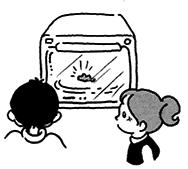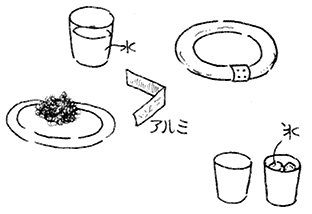Internet Version [Naruhodo no Mori] Vol. 16
by Yumiko Mori

Vol. 16 March 15th, 1996



Zzzzzzzz!!
Toshi: "Amazing! It sounded like thunder!"
Mom: "I am shocked. I thought the microwave was going to explode."
Toshi: "The edge of the foil is melting. It's amazing!
Let's do it again."
Mom: "Again? I hope you will not break the microwave, Toshi!"
We have to have brave mind when we place a fluorescent light tube
into the microwave machine and turn its switch on.
The microwave did not break. Mom is so pleased.
Next, we put ice cubes into a cup and microwave them.
Mom: "It's true! Ice doesn't melt!
It's really strange, because water is extremely hot on the other hand.
Toshi: "Mom, what did you find?"
Mom: "I found ice did not melt.
It's strange because frozen beef can be defrosted by microwave."
Toshi: "I guess what happened is heated beef melted ice around it."
Mom: "You sounds clever! Anyhow,
it's so surprising to find ice does not melt in the microwave. "

 Each experiment takes only 5 min.
Each experiment takes only 5 min.
* Microwave was used for radar during the W.W.II.
These electromagnetic waves can stimulate water molecules.
Thus microwaves can heat up food containing more water efficiently.
* Do not continue the experiments #1 or #2 more than 1 min in total, because these experiments may cause damage to microwave machines.
* Metal materials can reflect microwaves, but when microwave hits pointed parts of metal,
free electrons move very rapidly and heat is produced.
The reason why metal mesh is attached on a microwave window is to prevent microwave from leaking out.
* In a fluorescent light tube, moving electron collides to electron of mercury atom, emitting photon, which subsequently hits the tube wall and make fluorescent light.
* Ice is a solid material made of water molecules. Because its firm arrangement of molecules, microwave can not stimulate the vibration of the water molecules.
My children loved the sparkles we made in the microwave. On the other hand, I was most amazed by a fact that ice did not melt in the microwave. Why can we defrost frozen beef but not ice? I was so curious, that I investigated about ice. I learned the properties of ice are quite complicated. When you leaned one thing, you want to ask further questions. I don't think I myself can understand these difficult problems. But scientists are pursuing unsolved problems further and further.
| Author | Yumiko Mori (Zushi, Kanagawa, Japan) |
|---|---|
| Illustration | Mitsue Ogata |
| Translator | Akira Ishihara |
| HTML format | Muneo Kume |

